The power of the eruption “seems to be decreasing”, the Icelandic Meteorological Institute said on Tuesday morning. It is located a few kilometers from Grindavik, a town of around 4,000 inhabitants already evacuated in November after strong seismic activity.
Published
Update
Reading time: 3 min

A wall of fire four kilometers long. The volcanic eruption which began Monday evening continued on Tuesday December 19 in Iceland, in an area located south of the capital Reykjavik, according to the Icelandic Meteorological Institute (IMO).
The power of the eruption “is decreasing”noted the IMO on its website Tuesday morning. “The fact that activity is already decreasing is not an indication of how long the eruption will last, but rather shows that the eruption is stabilizing,” however specified the institute.
At 10:17 p.m. (local time), cameras placed in the area captured images of incandescent lava cutting through the dark night. This new eruption, the fourth in two years, took place three kilometers from a town of around 4,000 inhabitants. Grindavik was already evacuated on November 11 after a state of emergency was declared in the region linked to a significant accumulation of magma.
“No country is better prepared for natural disasters than Iceland”, said Prime Minister Katrin Jakobsdottir on November 18 during a press conference. The crack was initially estimated at nearly 2.8 km by the IMO, a measurement already three times larger than that recorded during the previous eruption last summer. According to the institute, the aviation color code changed to red, before quickly returning to orange, in the absence of an ash cloud.
This is not a “tourist eruption”
All roads around Grindavik are closed, and are expected to remain closed for the next few days, police announced on Facebook. According to the authorities, in the current situation, the population is in no danger. Flying over the area allows you to get a close look at the crack that formed and the lava that gushed out.
Since March 2021, several volcanic eruptions in an uninhabited area nearby have become major tourist attractions, attracting nearly 680,000 visitors, according to the Icelandic Tourism Board. However, the head of civil protection and emergency management in Iceland Vidir Reynisson warned that the phenomenon observed since Monday “is not a tourist rash and you have to look at it from a very far distance”.
Several decades of activity in sight?
Until March 2021, the Reykjanes Peninsula, south of the capital, Reykjavik, had been spared from eruptions for eight centuries. Since then, two others (in August 2022 and July 2023) have taken place, a sign, for volcanologists, of a resumption of volcanic activity in the region. According to them, this new cycle could last several decades.
“Our thoughts are (…) with the local population [de Grindavik]we hope for the best, but it is clear that this is a considerable blowout”, Icelandic head of government Katrin Jakobsdottir wrote on Facebook on Tuesday. In 2010, the Eyjafjallajökull volcano, in the south of the island, caused the largest disruption to air traffic ever observed in peacetime.
